#Platform Developer 2 Dumps
Explore tagged Tumblr posts
Text
64 Dreams: A Look at Harvest Moon 64's Japanese Pre-Release Coverage
Fresh off the releases of the original Bokujou Monogatari in '96 and the GameBoy demake in '97, the series was starting to make a bit of a name for itself by 1998. The popularity of the GameBoy port in particular, partially credited by Yasuhiro Wada to the revived interest of the GameBoy as a platform thanks to Pokémon, led to some amount of anticipation for the follow-up.
At that time, a Japanese gaming magazine called The 64Dream, which was later renamed Nintendo Dream, was aimed exclusively at Nintendo 64 owners to give them the latest in information on upcoming and currently available games. Several issues over the course of a year would feature updates and information on Bokujou Monogatari 2. It would be a lot of work to translate everything, though we still might go over the really interesting bits some day, but, for now, we'll go over a brief summary of each issue's coverage up until release.
October, 1998
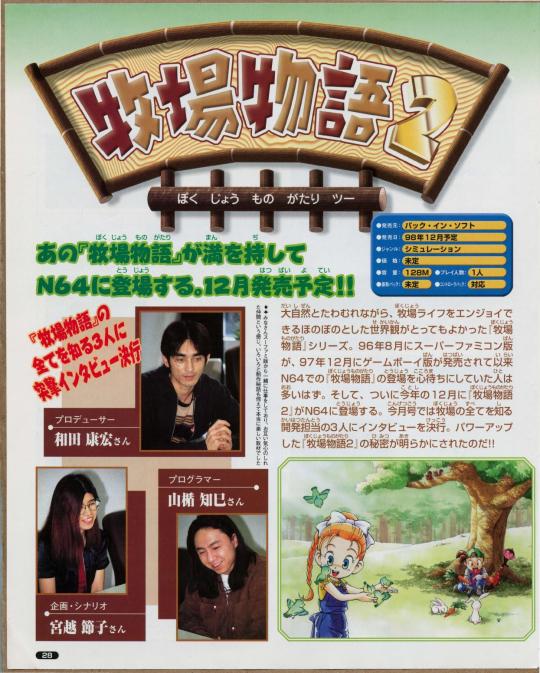





To start off the coverage of Bokumono 2, Yasuhiro Wada, Setsuko Miyakoshi, and Tomomi Yamatate are participating in a Q&A with the magazine's staff and introducing elements that are new from the SNES game like the camera, backpack, automatically leveling up tools, sheep, etc. Things to do during Winter are also referenced, like mining and the event to help out with Green Ranch, as well as it being a highly requested feature to continue playing after the ending. It also references the Goddess Fountain being the one from the previous game, which I hadn't really considered but if you think about the general layout of both maps it makes sense. The heart level system is also revealed to have a name the development staff used, the "Bakubaku system," which was implemented because sneaking a peek at their diaries wasn't the best thing to do. Since it's referencing a heartbeat, I guess if they localized that name it'd be something like "ba-dump system"?
There's a few tidbits that are completely different from the final game, like being able to carry bugs in your backpack, as well as an affection system for wild animals. Neither are in the release version, with wild animals being able to just be picked up freely without befriending them, and neither bugs or animals being willing to be stuffed into your bag. The calendar of festivals and other notable events is also a bit different, with no races or swimming events present at all, along with the Spirit Festival being on the 29th instead of the 27th.
There's also few interesting details among the artwork, like Harris being blonde and the baby's outfit being brown instead of blue. The artwork of the girls is also distinct here, with most of them not being featured in any other promotional material or guidebooks. Ran and Marie's artwork appeared in the 15th anniversary art book, but Karen, Popuri, and Elly were oddly absent. Rare stuff.
November, 1998



This month, the magazine's editors are getting to play for the first time. Most of the article is just them experiencing stuff that's new after the SNES game firsthand. Things like rotating the camera, having a bag, carrying multiple tools, tools leveling up with use, things like that. Oddly, Karen doesn't seem to appear in the demo, though the vineyard and other characters do. The article ends with some fan art of Karen and Pete at the vineyard. There's also some fan art of all the girls in the fan art section.
There isn't a lot here that's different from the final game this month, but there is a screenshot of the library with a completely different layout from the final game.
December, 1998



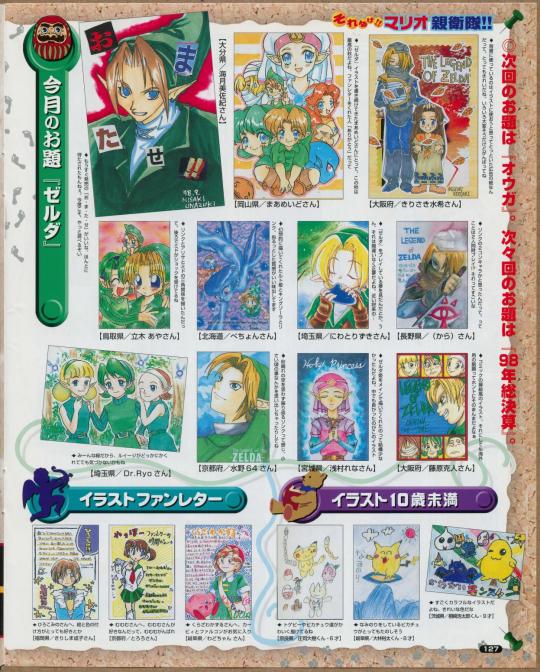

Wow, right off the bat there's lots of little art differences here. Mayor Thomas is blonde, Marie has blue hair like her grandma, and so does Kent! Though with that light of a shade, maybe Kent's is supposed to look shaved. The artwork for the town's map is also a little off, featuring a layout that's not present in the final game, and a few details that would go missing as well, like a tree outside the bakery. Of course, several new elements would be in the final game that are also missing from this artwork, like shop signs. I also appreciate all the little figures of characters wandering around the map.
The text doesn't look like anything new or distinct, but it does mention that there's now a racetrack. Horse races weren't mentioned at all in previous months, so maybe this was a late addition they finally felt safe confirming. It also mentions Duke being Jeff's uncle, which is something I tend to forget is mentioned in-game, as well as Doga's appearance being compared to Yoda, and... I can see it.
There's also a featured fan art this month at the end of the article featuring Ran and Pete sitting together. In the magazine's fan-art dedicated page, there's artwork of Popuri and Elly, too! Not to mention plenty of non-Bokumono fan art featuring characters from Wonder Project J2, Pokémon, and Ocarina of Time.
January, 1999


The article this month opens with lamenting that the game didn't release in December and will be delayed until February. Since we're pretty close to release now, it doesn't look like there's too many differences from the final game at this point. Of note, however, is that the animals all seem 500-1000 G cheaper. I guess they were still adjusting game balance. The crops listing doesn't include strawberries either, and a note that the seed prices might be different in the released game, but those are all correct.
The fan art this month is Pete with a bunch of farm animals, including a pig! I guess they'll have to wait until GBC3 and Magical Melody for that though. There's also a small figure on the left side, maybe holding a paintbrush? An artist's self-portrait, maybe?
February, 1999
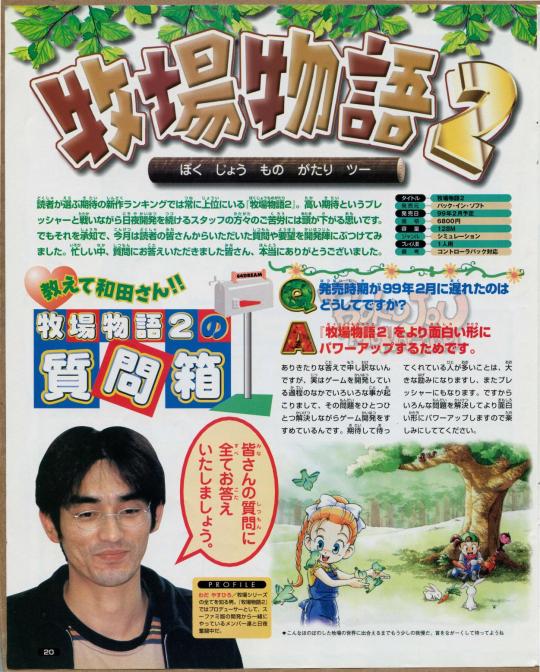
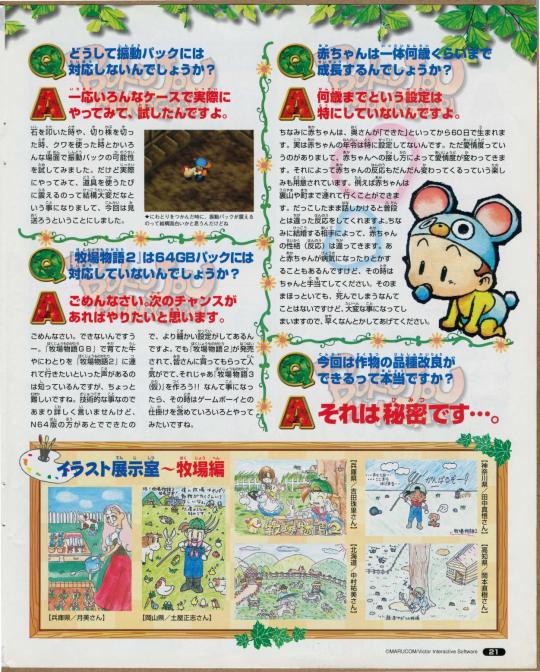
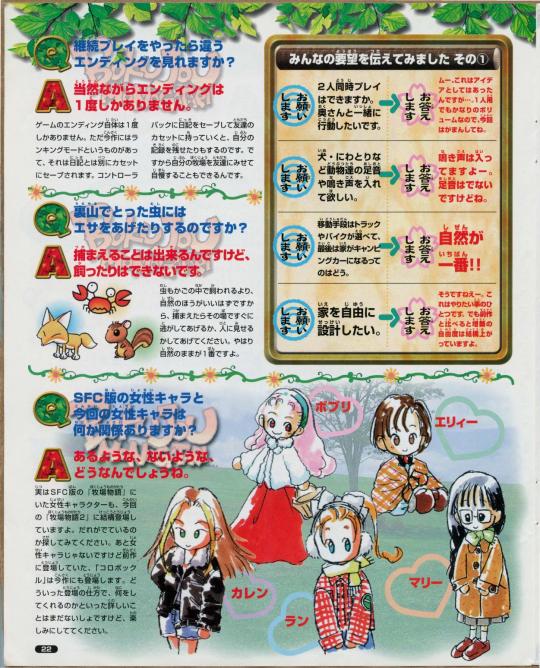

Finally, it's release month! The game has been consistently voted one of the most anticipated titles by readers, and Yasuhiro Wada is here to answer their questions.
The first interesting question is about the Nintendo 64 Transfer Pak, which Wada says wasn't possible to implement transferring cows and such due to technical reasons and the N64 game's development coming later. However, if the game was popular enough to release a Bokujou Monogatari 3 on the N64, he'd like to implement GameBoy gimmicks. Next, he's asked about the baby, and mentions that it will have different reactions based on where you take it, and that it will gradually change with level of affection. When asked about improving crop varieties, Wada replies that it's a secret. Maybe referencing the unlocking of Strawberries after getting a greenhouse? The page ends with a variety of fan art.
On the next page, a fan asks if there are multiple endings. Wada responds that there's really only one, but there's a ranking system in place. He also mentions that you can transfer your save to a Controller Pak and take it to a friend's house and compare your rankings with them, which is something North American fans missed out on when the rankings page feature was removed, along with several other things. Next is a question about catching and keeping bugs, which contrary to the mention in the October '98 issue, he says that leaving them in nature is for the best. The last question on the page asks about the girls from the original game appearing, which Wada says a few do in some way, and you should try to find out. Also that the same Harvest Sprites return. There's also artwork of all the 64 girls in cute winter outfits!
The last page is just basic gameplay questions, like how much money you start with and how to sheer sheep, with Wada going on to mention that taking care of animals is important and that there's a funeral scene for them now. The page closes again with more fan art.
More interestingly, the little boxed area on pages 22 and 23 features "requests" and general comments from fans. For page 22, the first of which is for co-op, which Wada says was an idea he also had, but to please bear with it as it wasn't possible, and there is a lot of content for one player in the game. Next, he's asked for the animals to make noises and have footstep sounds, which he says they do make animal sounds (mooing, clucking, etc) now, but don't have footstep sounds. Then he's asked about implementing a motorcycle or truck! Wada emphatically responds that nature is best.
Page 23's requests start with being able to freely design the house, which Wada also wants to do, but there are at least more extensions this time. Next, a player wants the hot springs to return, which Wada says might appear in this game as the player progresses. Another player comments that they hate natural disasters like typhoons, but Wada says they will be returning in this game, albeit less frequently. Someone asks to be able to make cheese, yogurt, and ice cream, which Wada says sounds great. Someone asks about the Hoe transforming into a tractor after it reaches level 4, which Wada brushes off as "too much," someone asking to put an N64 in the house, which Wada says sounds nice, but there's too many things in there already, and lastly someone comparing Wada's appearance to Yabe-san from the comedy duo "Ninety-Nine," which Wada disagrees and laughs at.
And that's it! Shortly after this magazine hit shelves, the game would finally release. There were several months of coverage afterward, which we'll probably go over, but that'll be for another time. A big thank you to ozidual of Gaming Alexandria for allowing us to use their scans. You can check out their full magazine scans on Archive.org.
#harvest moon#story of seasons#harvest moon 64#64Dream#64 Dream#Magazines#Magazine Scans#1998... I'll never forget it.#Ninety-Nine also did the “Hot Mario” commercials#but obviously Yabe looks like Mario there so we didn't link it#the various requests remind me a lot of the wishlist on HM Farm#the mention that bikes are too much does make me wonder about the one from Olive Town though...#it did kind of make horses irrelevant#official art#scans#magazine#karen#elli#pete#marie#mary#elly#ann#ran#maria
89 notes
·
View notes
Text
Art Dump!
Decided to put my art in tumblr because frankly Twitter/X and Instagram isnt giving...
⚠️⚠️⚠️theres a suggestive drawing in there, nothing too much but just a warning⚠️⚠️⚠️
I put Glaze on these art...Im not quite sure I like how the end looks but...the price you have to pay these days 😮💨

-my old png tuber model!
Im not yet a pngtuber, I didnt have the guts to stream with people in the same room as me (but hopefully making myself introduce as one will pressure me enough to actually go through with it)

-whole art piece of my old model
I drew this first before even deciding I want it to be a model
do you like my attempt at making a background? lol

-An orange cat OC
Her name's Hekal??? I forgor...its been a year and some T. T
As you can see my handle used to be Tori Tonkatsu- too long changed it....I do miss the lil frog guy ngl




-Some emotes for Hekal! (Im sticking with Hekal)
I liked drawing her since her head is shaped like a turtle very cute :D

-MORE OC!
I dont think I gave them name?? -oh geeze this is 2 years old time flies, and also I really should put dates in my art...
Anyway, look at that platform heels?? popped off Im afraid
Also I remember putting finishing this off because this is my first time drawing two characters in one canvas, but hey it turned out great!
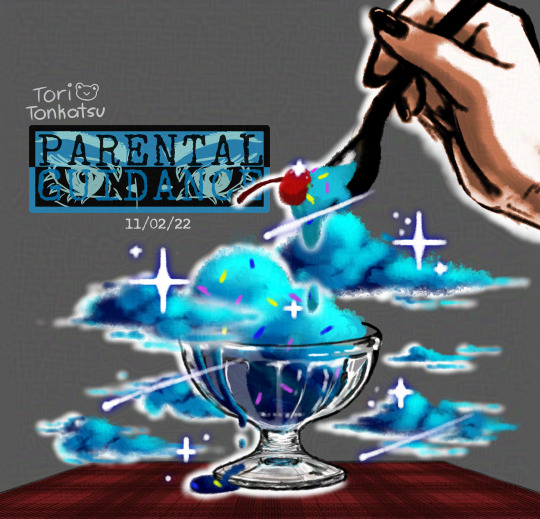
-A dessert thing...
Im not the most proud of this but look at the neck of that glass and tell me its not eating
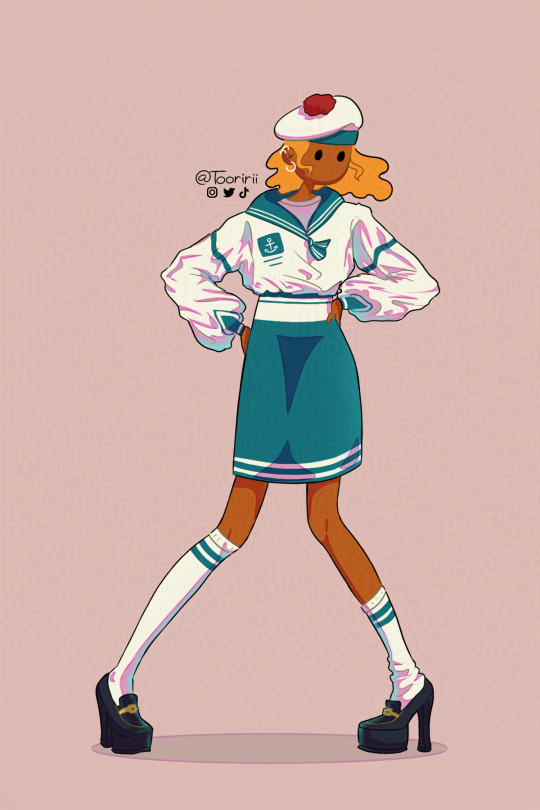
-random sailor girl
long story short: saw cool pose and cool clothes in pinterest
did develope an artstyle though, I quite liked the pink and blue hues, and my new name as well! And yes I do have tiktok but as Ive mentioned at the very start, left Twitter/X and Instagram


-THIS WAS A TREND OKAY
but im still proud of they way i rendered this, because LOOK AT THOSE SHOOEESS and socks uwu

-Commission for a friend
That friend is so nice to commission me
I had fun drawing the clouds, but its been quite a while so I have to re-learn that huhu T >T
Honestly I think as an artist I dont give myself credit enough and looking back through these old art makes me realize that I did draw quite a lot and gave it my best too!
Anyway thats it for now! Just decided to share this pieces.
+Im on Youtube (just did my first live stream!) and TikTok!
@Tooririi
See you later! <3
#TooririiTalks#TooririiDraws#Been listening to Chapell Roan and Sabrina Carpenter and damn I am eating a full course meal#artists on tumblr#my art#digital art#drawing#my ocs#oc art#original character#nura rikuo#JackBox mascot#jack in the box#jackbox#pngtuber#giftuber#old art#chibi art#chibi character#glazed art#glaze#livestream#art stream
7 notes
·
View notes
Text

Tried my hand at the ol' "display your own gallery" trend we were all doing a while ago! (ft. some of my latest, strongest work and pure vibes)...
»--•--«
Hello out there again!!
I'm going to be re-sharing a lot of the free content I've been posting to Patreon because I've realized that's about the only place I'm active right now aaaand that needs to change.
So, while I'll probably reblog the Timeline Tuesday posts later on for the sake of continuity, I figured I'd start with a modified version of my intro post explaining WHY I'm moving primarily to Patreon:
»--•--«
For those of you who might be finding my page for the first time or are otherwise less familiar with me:
Hello! Allow me to introduce myself:
My name is Ripley (Artistic Menace, or R. A. Menace), and I'm the creator of Broken Dimensions, an in-development sci-fi fantasy project universe!
I am an illustrator and author with experience in illustration, creative writing, story and concept dev, graphic novel development, and social media. I'm also a recent graduate from a digital arts program at a non-art university, and I have big dreams for getting my art and stories out into the world.
The goal of starting my Patreon is to develop platform that not only works well with my work schedule, but also allows me to form a comprehensive, easy-to-follow guide and resource forum for Broken Dimensions. However, I work retail 4-6 days a week. My ability to work on or share art or writing is limited. In addition to this, the world (especially that of the entertainment industry) is a mess right now!
That's where you come in:
While most of the introductory worldbuilding stuff for Broken Dimensions will be always available on a free tier, now that we're past a certain point I have begun posting special art, worldbuilding progress, constructed language info, special content, and prose on paid tiers. Work published to the free tier has been somewhat reduced and/or continues to be released later than on the paid tiers. I kindly ask that those of you who find my work interesting continue to support me by becoming paying members!
You can support me financially by joining any of the three Patreon tiers:
"ooo, shiny!" (tier 1, $2/mo)
Monthly sketch dumps
All paid worldbuilding posts
Most finished illustrations
And more!
"woah! SUPER shiny!" (tier 2, $5/mo)
Everything in tier 1
Weekly sketch dumps, plus my ramblings
Early access to all finished artwork
And some other things!
"SHOOTING STAR!!"
Everything in tiers 1 and 2
Written fiction of all kinds, including snippets and WIPs
Smut (written and drawn)?? (Still working this one out)
Monthly shout-outs
Possibly requests??
If you cannot support my financially that's okay! Please consider sharing my posts, social media pages, and shop links instead.
You're welcome to re-share these social media platforms and links to anything on them:
Cara | artistic-menace
Bluesky | artistic-menace
Instagram | artistic_m3nace*
This tumblr!
If you're willing and able to support me financially, you're also able to support me through Redbubble and INPRNT!
Redbubble | Artistic Menace
INPRNT | Ripley Poremba
»--•--«
There's still a lot of progress to be had when it comes to posting, themes, and updates on Patreon. For more on that, read the March Update Post that has more details on my current situation and reasoning.
For now, that's all! I hope you'll continue to follow along as I build up the narrative of Broken Dimensions and prepare to share more awesome art.
#introduction#patreon#digital art#artist#illustrator#illustration#artists of tumblr#support queer artists#queer artist#queer illustrator#original artwork#stay tuned#my art
2 notes
·
View notes
Text
Finally, an Ace Combat Fanfic (or two)
Finally got my AO3 account approved, so I posted my first (two? Do 2 Chapters count) fanfics, and its of Ace Combat Zero & 6 (Ciphixy & TaliSham) - Featuring... some plot with subtle horror AND smut. Also, I realized that I cannot write pure vanilla T_T
AO3 link here - F*ck like you fly
Additional notes that were not mentioned on AO3 as they were linked to HCs: under the cut.
The protags are technically male. But because I sometimes also draw them as females + because they are faceless, they are written to also have some feminine qualities in their appearance. Or, they may not be human at all, considering the way they fly; and their wingmen will do well not to forget that they are predators, no matter how alluring or nice they seem to be.
-----------------------------------------
AC6’s Shamrock/Talisman are my rare pair. Their story started out when I was thinking about how they’d ever get together, considering how much baggage Shamrock has. And I just happened to write it down, and by that time it was already a full-length fic. Might as well dump it on AO3.
-----------------------------------------
ACZ and AC6 go together for me. I find them like mirror images of each other and hence, easier to write or draw as a “set”. Besides a weakness for the Angel and Demon trope (I blame Neil Gaiman and Terry Pratchett for writing Good Omens), I think ACZ and AC6 were purposeful corporate “mirror projects”: ACZ and 6 were developed around the same time (release date 2006/2007 - the only 2 main platform games in the AC series developed so close to each other), and both teams prob practically, in a very corporate fashion, were given tasks to focus on building FACELESS protagonists that were opposite just to ensure no overlaps when the biz was running 2 similar projects. As a testimony to some of the development similarities, the Garuda team even had a 3rd wingman (but dropped), very similar to the Galm Team.
Note: This a hypothesis based on understanding & practical experience of messy, large corporate cultures. Unproven in the Namco (pre-merger) context, but I guess similar patterns prevail across industries?
So, I think the Demon of Ustio was conceived first and management just went like ok, corporate has a demon now, this faceless thing is gonna be a challenge if we’re running 2 concurrent games cos we just can’t make them LOOK different, let’s do an angel/ angels for the other one so there will absolutely be no way we can clash the characterizations. The Angel and Demon trope was just too convenient and I think that resulted in Cipher and Talisman being developed to achieve the same outcome (ace pilots who are a cut above the rest, instrumental to winning the wars they were in etc), while being the exact opposite of each other.
A feared mercenary bound to no rules | An admired leader in the air force. Lone contributor | Strategist. Fear inspiring | Awe inspiring. Faces off against a wingman who breaks orders | Stays together with a wingman who breaks orders. Both their wingmen are also highly effective but one turned out to want to kill them | the other will die for them.
At the end of the day, Ciph & Tali would both be annoyed at how similar they really are despite trying to be so different (affectionate) - hence the basis of their beef in the chaotic ACZ/6/7 AU that sometimes features here. But they do have a grudging respect for each other and might bond over their shared love for capable-idiot wingmen (again affectionate), and TROUNT lol.
And after all, both are still to be feared, bringing salvation and destruction in their own way. Cipher - all shall fear me and despair | Talisman - all shall love me and despair. Pun intended cos they fly Eagles, but not to Mordor.
-----------------------------------------
Would like to try writing Trount sometime, perhaps as a 3rd chapter. But due to their lighter hearted nature, they are a little more challenging to write with the subtle-horror undertone vs the ACZ and AC6 pairs. I will get there!
#ace combat#ace combat zero#ace combat 6#fanfic#first time writing#and I do this#I am a degenerate lol#Ciphixy#TaliSham#Future Trount Maybe#Making the MOST of work commutes#these took so long frankly#Headcannon ramblings#shippy stuff#Supernatural and horror elements#I think their wingmen are done for lol
13 notes
·
View notes
Text

5 Major Tips to Write a Sci-fi book
These are excellent tips for writing a sci-fi book! Let me expand on each one for more depth:
1. Build a Solid World (Expand Beyond the Basics):
Consider History & Culture: Think about how the world’s past shapes its present. What are the cultural norms, religions, and political structures? How has technology or alien encounters shaped these aspects?
Diversity of Settings: Sci-fi worlds often span galaxies or include different planets or societies. Make each location feel distinct, with its own geography, climate, and people.
Technology & Innovation: Explore how technology affects everyday life, social structure, and relationships. Consider innovations like AI, space travel, or futuristic healthcare systems, and think through their ethical and moral impacts.
2. Incorporate Thought-Provoking Themes (Layer Deeper Meanings):
Ethics of Science: Explore the consequences of unchecked scientific discovery, like AI surpassing human intelligence, genetic engineering, or life extension. Ask moral questions about the balance between progress and humanity.
Social Commentary: Sci-fi can be an allegory for modern issues like climate change, inequality, or government surveillance. Use futuristic scenarios to hold a mirror up to contemporary problems, forcing readers to reflect on current realities.
3. Craft Well-Defined Rules (Science & Speculation):
Establish Physical & Societal Laws: Whether you’re dealing with space travel, alternate dimensions, or alien species, your world needs rules. Are faster-than-light travel and telekinesis possible? If so, how do they work? Set the boundaries early and stay consistent.
Explain Science, Don’t Lecture: It’s important to have plausible science, but avoid overwhelming readers with technical jargon. Integrate the science seamlessly into the story, showing how it functions through character interactions and world events.
4. Focus on Character Development (Relatable Characters in Extraordinary Worlds):
Complexity Over Archetypes: It’s easy to fall into classic sci-fi character tropes like the rogue space captain or the genius scientist. Give your characters depth—let them have flaws, personal goals, and emotional arcs. They should evolve as they interact with your world.
Relationships Matter: Even in a futuristic setting, human emotions and relationships remain universal. Whether it’s love, friendship, or rivalry, make sure these dynamics drive your story forward. Your characters’ interpersonal struggles should be as compelling as the cosmic conflicts.
5. Balance Exposition with Action (Show, Don’t Tell):
Reveal Through Action: Instead of dumping all the backstory and rules of your world in one go, let them unfold through your characters’ experiences. For example, show how a piece of tech works by having your character use it in a tense situation rather than explaining it outright.
Pacing: Keep a steady rhythm between slower, introspective moments and fast-paced action scenes. Readers need breathing room to absorb the world-building but also crave excitement to keep them turning the pages.
Additionally, research can help ground your speculative ideas in reality. Reading about current advancements in space travel, artificial intelligence, or genetic research can inspire more plausible and grounded futuristic technologies.
Lastly, sci-fi allows you to push boundaries. Embrace creativity, but always anchor it in compelling storytelling and relatable characters. For further reading, platforms like Amazon Kindle or Shabd.in have a great selection of sci-fi books to explore!
Source -
2 notes
·
View notes
Text
@chapeliier asked . 2, 4, 6, 8 !
* interview the writer
2 — is there a song that reminds you of your muse?
When everyone You thought you knew Deserts your fight I'll go with you You're facing down A dark hall I'll grab my light And go with you
* gestures wildly to the sins *
4 — do you have any advice for other writers?
take your time ! not everything has to be perfect , characters develop over time and the same goes for the whole blog. graphics sure are nice , fancy themes too BUT remember people are here for YOUR CHARACTER and how you write it !
trying to ingrain that in my head too after eh 11 years on this platform
6 — how are you and your muse alike?
more than i'd like to admit , the tendency to always reach out to help even before being asked , placing others higher than yourself and your needs. to say we both care too much for our own good which leads to confusion socially especially when giving affection easily and publicly.
also our tend to sleep ungodly amounts is another ygherlg
8 — do you follow canon, or dump it in the trash?
i am a bit of both , usually i use canon as the ' base ' stuff and then fill it out as your imagination allows.

canon is good but blogs that stray from canon is just that much more interesting in my humble opinion.
1 note
·
View note
Note
Do you use any discredited communication method such as Facilitated Communication??
(RPM is not “better than FC.” It is FC rebranded. The individual holding the letterboard still holds the letterboard and moves it, whether subconsciously due to ideomotor effect or on purpose. Victims are not allowed to resist verbally and are not encouraged to develop the verbal speech they already have. It’s taken as “meaningless unreliable speech” and ignored. Autism is NOT primarily a motor control disorder, which is one of the biggest lies of FC, and “impulsive speech” has NOT been backed by tje scientific autism literature. It is invented by “FC users” and their facilitators as a post hog rationalization of why verbal FCed people can say things that contradict their FCed or RPMed words. )
It is also very suspicious how most notorious FC users and those paraded as “success stories”, have since “disappeared” from the public eye entirely. https://www.facilitatedcommunication.org/blog/mysterious-disappearances-in-the-world-of-fc-what-does-it-take-to-sustain-the-illusion I suspect this will also be the case with new “tumblr generation” and more to come with the new variant, S2C. The author of this piece is a former facilitator who was involved in the infamous Betsy Wheatson case, in which she made her victim falsely allege abuse against a parent and tore her family apart. We only know the fate of two in the article, Tito M. and Amy Sequenzia. The former his mother still parades around, the latter she’s living in a facility after her facilitator (father) abused her. Organizations like ASAN had those like Amy on their board when her words are not her own so she could not have been called a “self advocate.” We shouldn’t even know these profoundly autistic people, if it wasn’t that their facilitators made it their mission to advertise them as FC role models and marketing purposes. They were used, now nowhere to be seen.
Others who are paraded as “success stories” within FC have a trajectory that I’m beginning to suspect may be the case with you. Amanda Baggs, for example, claimed to use FC, but was really a malingering schizophrenic who went to early college program perfectly typical with no issues. She may have had a late regression as many on Tumblr like “five thousand loaves of bread” claim to have. She claimed to have catatonia which many on this platform claim as well. Either way that didn’t matter in the end, because she was still subject to the practice of FC and she too mysteriously disappeared as of 2020 alleging medical abuse and no one knows where she is to this day. She is still cited as a “foundational neurodiversity advocate” and so is Amy S. , Carly F, Naomi H and Sharisa K. So is Donna Williams, a multiple personality case with an autistic “alter” who later claimed to be a severely autistic person. All these people are either abused and exploited or greatly exaggerated their disabilities. I suspect this may be the case with you and those like you.
If we are supposed to feel bad about not presuming competence of these folks, why are we supposed to feel good about Amy dumped and mistreated, about Carly (who notoriously went missing after a molestation accusation?) And why are we supposed to listen to these Tumblr users who are consigned to similar fates? Why should we listen?
post this for archive
.
now that block them so talk little (overwhelm w stuff so short)
1. interesting i not get the “are you really nonverbal” bc think this person inherent not believe me & regress (judge by mention my url & “suspect this may be case for you/those like you”)
2. not do good job proof read before copy paste send because “as many on tumblr like (my url) claim have” when send ask to me
18 notes
·
View notes
Text
App Store Submission Process Made Easy A Guide for First-Time Developers
Releasing your first mobile app That’s huge. You’ve put in countless hours building something that solves a problem, entertains, or simply makes life easier. But now you’re standing at the gateway the app store submission process and it can feel like decoding an ancient scroll.Don’t worry. You’re not alone. Submitting an app to the App Store (whether it's Apple’s App Store or Google Play) has its own set of challenges. This guide is designed to walk you through the entire process without the jargon, without the guesswork, and without the headache.
Understanding the App Store Submission Process What First Time Developers Need to Know
Before you can showcase your app to the world, it's important to grasp the basics of the app store submission process. Whether you're building for iOS or Android, each platform has its own ecosystem, review policies, and formatting requirements.
Apple has a notoriously meticulous review system. Think of it as a tight club with a velvet rope.
Google Play is more flexible, but still requires attention to detail.
Bottom line? It's not just about uploading an app file. You're stepping into a highly curated marketplace. Every element from app screenshots to metadata matters.
Step-by-Step Breakdown of the App Store Submission Process for iOS Developers
If you’re targeting iPhone or iPad users, the Apple App Store is your playground. Here's what you need to do:
1. Join the Apple Developer Program
Cost: $99/year
Purpose: Grants access to development tools, beta testing, and submission capabilities
2. Prepare Your App
Test, test, and test again
Use TestFlight for beta distribution
Ensure your app complies with Apple’s Human Interface Guidelines
3. Set Up Your App Store Connect Account
App Store Connect is where you manage everything: app metadata, pricing, screenshots, and analytics
4. Complete App Information
Choose your app name, description, keywords, support URL, and privacy policy
Write a compelling description that’s SEO friendly without sounding like a keyword dump
5. Upload with Xcode
Archive your app and upload it directly through Xcode
Validate everything before submission
6. App Review & Approval
Most reviews take 24–48 hours, but can take longer if issues are found
If rejected, you’ll receive notes from Apple on what needs fixing
Navigating the Google Play Submission Process: Android Developers, This One’s for You
1. Create a Google Play Developer Account
One-time fee: $25
Required to access the Play Console
2. Prepare App Assets and Information
Screenshots, feature graphic, icon, and promotional text
Write a user-focused, benefit-driven description Google uses this for ranking
3. Upload APK or App Bundle
Use Android Studio or manually upload your file in the Play Console
4. Set Content Rating, Pricing, and Distribution
Choose your app’s category and age rating
Set the regions where it should be available
Google's review usually takes a few hours to a few days
If flagged, make corrections and resubmit
Common Pitfalls in the App Store Submission Process (And How to Avoid Them)
Even seasoned developers can trip up during submission. Here are the most common mistakes and how you can sidestep them:
Skipping Beta Testing: Use tools like TestFlight or Firebase for real-user feedback
Poor Metadata: Don’t stuff keywords; write naturally, but include terms users might search for
Privacy Policy Errors: Make sure your app has a clear, compliant privacy policy especially if it collects user data
Misleading Screenshots: Be honest—Apple and Google both penalize apps that exaggerate functionality
SEO Tips for Optimizing Your App Store Listing
Remember, your app’s store page is just like a landing page. You want it to convert. Here’s how:
Include the keyword "app store submission process" naturally in your description
Use high-quality visuals that accurately reflect in-app experience
Feature a strong opening sentence that’s what users see in search results
Encourage user reviews once your app is live ratings impact rankings
How Creatah Helps You Streamline the Entire App Store Submission Process
Let’s be honest the development is tough, but the app store submission process can be a major roadblock if you’re not familiar with the rules of the game.
We specialize in customized software solutions tailored to your business goals and that includes getting your app through the app stores, fast and frustration-free. From UI/UX polishing to metadata optimization, Creatah helps you avoid costly submission delays and ensures your app gets the attention it deserves.
Whether you're launching your very first app or scaling an existing digital product, we make sure every detail is aligned for approval and success.
0 notes
Text
Farming and Agriculture in 2025: Game-Changing Secrets to Skyrocket Yields and Secure Your Legacy
The international of farming and agriculture is present process a big shift, driven by means of weather exchange, technological innovation, transferring client demands, and sustainability challenges. As we step similarly into 2025, it is extra crucial than ever for farmers and agricultural specialists to conform, embody innovation, and take control of their future.
If you are a farmer trying to maximize yields, boost profitability, and create a long-lasting legacy for the subsequent era—this weblog is your roadmap. From breakthrough agricultural technology to regenerative farming strategies and clever choice-making, those game-converting secrets will assist revolutionize your approach to farming and agriculture.

The Evolution of Farming and Agriculture
Farming is no longer what it was once just a few a long time ago. Where as soon as traditional gear and guide exertions ruled the fields, now drones, records, climate tech, and soil technology are reshaping the agricultural panorama.
The key focus in 2025 is not simply productiveness, however sustainability, performance, and resilience.
Secret #1: Embrace Precision Agriculture
If there’s one word you’ll listen frequently in 2025, it’s precision agriculture.
Using tech like GPS mapping, IoT sensors, drones, and farm control software program, you could now make real-time decisions about your vegetation, water utilization, pest control, and fertilizer application.
Benefits:
Eliminate guesswork and decrease waste
Optimize yield in line with acre the usage of satellite tv for pc statistics
Monitor each square meter of your field remotely
Cut down charges at the same time as growing productivity
According to the FAO, farmers the usage of precision farming in 2023 noticed up to 30% increase in crop yields—a fashion it truly is simplest developing more potent.
Secret #2: Master Smart Water Management
Water scarcity is one in all the most important threats to worldwide farming.
2025 farmers want to rethink water utilization through the usage of smart irrigation systems like:
Drip irrigation – Delivers water at once to the roots
Soil moisture sensors – Prevents over- or below-watering
Weather-based totally irrigation scheduling – Uses climate facts to automate watering
💡 Pro Tip: Use AI-based totally irrigation apps to track rainfall, expect weather styles, and exactly control water distribution across fields.
Secret #3: Regenerative Farming for Soil Revival
Years of chemical use and over-farming have left soils the world over depleted.
Regenerative agriculture is the name of the game weapon for the future—restoring soil fitness while improving productivity.
Best Practices:
No-till farming: Reduces erosion, preserves soil shape
Cover cropping: Keeps soil included and nourished yr-spherical
Composting: Boosts organic rely and microbial lifestyles
Crop rotation: Breaks weed cycles and decreases dependency on chemicals
Healthier soil equals stronger vegetation, better water retention, and higher, extra resilient yields.
Secret #4: Integrated Pest Management (IPM)
Dumping chemical insecticides is so 20th century—and dangerous to ecosystems. Today, Integrated Pest Management helps you maintain your vegetation safe the use of smarter, cleanser strategies.
Components of IPM:
Biological manage: Introducing natural enemies like ladybugs
Botanical insecticides: Neem oil, garlic sprays
Cultural practices: Crop rotation, entice cropping
Mechanical controls: Physical traps and boundaries
IPM not best protects yields but additionally boosts biodiversity and decreases long-term prices.
Secret #five: Use Farm Management Software
Want to paintings smarter, now not more difficult? It’s time to head virtual.
Modern farmers in 2025 use robust platforms and apps to:
Monitor climate
Track stock
Plan crop cycles
Analyze yield records
Get pest or sickness indicators
👨💻 Popular Farm Tools:
AgriWebb
FieldView
FarmERP
CropIn
These tools assist make higher decisions, quicker, and make certain you are getting the most out of each hectare.
Secret #6: Go Organic (or Hybrid)
As clients demand purifier, greater ethical food, natural produce is booming. Organic farming is a rewarding route if executed right—but it takes cautious making plans.
Alternatively, hybrid farming combines organic practices with clever generation and selective chemical input for balanced effects.
Key Moves:
Choose high-yield, resilient seed varieties (natural
Begin small – one area or crop at a time
Use bio-fertilizers and composts for vitamins
Tackle pests with natural or organic methods
Organic farming not most effective preserves the land for destiny generations but can fetch top rate charges in the market.
Secret #7: Choose Climate-Resilient Crops
With climate styles turning into unpredictable, traditional crops might also now not be dependable. In 2025, ahead-thinking farmers are testing and making an investment in weather-resilient plants.
Examples:
Heat-tolerant rice and wheat
Flood-resistant maize
Drought-tolerant pulses and millets
Perennial grains that require much less tillage
Not simplest do these reduce danger, but in addition they destiny-evidence your farm in opposition to environmental uncertainty.
Secret 8: Tap into Government Assistance Programs
Most countries now recognise the importance of helping farmers undertake present day practices. In India, for example, schemes like PM-KISAN, Soil Health Cards, and Fasal Bima Yojana are using effective alternate.
What to Look For:
Subsidies on seeds, fertilizers, and clever equipment
Training for virtual agriculture
Crop insurance and loss safety
Renewable electricity guide (solar water pumps, etc.)
Use those programs as stepping stones to modern, smart farming and agriculture success.
Building Your Farming Legacy
Farming has continually been extra than just setting seeds into the ground—it's a manner of existence. In 2025, it's also a enterprise, an possibility, and a obligation.
By embracing innovation, caring for the earth, and putting information into action, you're not simplest growing higher vegetation—you’re securing your legacy on your youngsters and future generations.
It’s time to develop smarter, greener, and bolder.
Final Thoughts
The destiny of farming and agriculture isn’t coming—it’s already here. Whether you are a smallholder farmer or handling masses of acres, the secret to thriving in 2025 lies in transformation.
0 notes
Text
10 Essential Things You Need to Know About Monologues

A monologue is one of the most powerful tools in storytelling, theater, and everyday communication. Whether you're an aspiring actor, writer, or simply curious about this dramatic technique, understanding monologues can enrich your appreciation of literature, film, and performance art.
1. The Basic Definition
A monologue is a long speech delivered by one person, either to other characters or directly to the audience. Unlike a dialogue where multiple people exchange words, a monologue gives one character the stage to express their thoughts, feelings, or tell a story without interruption. For a deeper understanding of What is a Monologue, it's helpful to explore the various forms and purposes this serves.
2. Different Types of Monologues
Monologues come in several varieties. An interior monologue reveals a character's inner thoughts, while a dramatic monologue is spoken aloud to other characters. A soliloquy is a unique form of speech in which a character talks to themselves, typically sharing their inner thoughts with the audience. There are also comedic monologues designed to entertain and tragic monologues that convey deep emotion or sorrow.
3. Purpose in Storytelling
Monologues serve multiple purposes in storytelling. They can reveal character motivation, provide background information, advance the plot, or create emotional impact. Writers use monologues to give audiences direct access to a character's mind, creating intimacy and understanding that might be difficult to achieve through regular dialogue.
4. Famous Examples in Literature and Theater
Some of the most memorable moments in literature and theater are monologues. Shakespeare's "To be or not to be" from Hamlet is perhaps the most famous soliloquy in English literature. In modern theater, plays like "The Vagina Monologues" by Eve Ensler have built entire productions around the monologue format. Movies also feature powerful monologues, such as the courtroom speech in "A Few Good Men" or the mirror scene in "Taxi Driver."
5. Structure and Components
An effective monologue usually follows a structured format with a distinct start, development, and conclusion. It starts with a hook to grab attention, develops the main idea or emotion in the middle, and concludes with a strong finish that often reveals something important about the character or situation. The best monologues feel natural and conversational, even when dealing with profound themes.
6. Performance Techniques
Delivering a monologue requires specific skills. Actors must maintain audience engagement without the support of other performers. This involves using vocal variety, physical gestures, and emotional range to keep the performance dynamic. Pacing is crucial – knowing when to speed up for excitement or slow down for emphasis can make or break a monologue.
7. Writing Your Own Monologue
When writing a monologue, start with a clear objective for your character. What is the speaker’s main goal or intention behind delivering their message? Give them a distinct voice that reflects their personality, background, and emotional state. Include specific details and personal experiences to make the monologue feel authentic and relatable.
8. Monologues in Different Media
While traditionally associated with theater, monologues appear in many forms of media. Television shows use them for character development, podcasts often feature monologue-style storytelling, and social media platforms have created new spaces for personal monologues through video posts and spoken-word content.
9. Common Mistakes to Avoid
Many beginning writers and performers make similar mistakes with monologues. Avoid making them too long or preachy – audiences can lose interest quickly. Don't use monologues to dump information that could be conveyed more naturally through action or dialogue. Also, ensure the monologue serves the story rather than just showcasing the writer's or performer's skills.
10. The Impact on Audiences
Well-executed monologues can create powerful emotional connections between performers and audiences. They offer moments of reflection, revelation, and catharsis that can be more impactful than entire scenes of dialogue. The intimate nature of monologues allows audiences to feel as if they're receiving personal confessions or witnessing private moments.
Conclusion
Understanding monologues enhances your appreciation of storytelling across all mediums. Whether you encounter them in classic literature, modern theater, or contemporary film, recognizing the craft behind these solo performances can deepen your engagement with the story being told. For writers and performers, mastering the monologue is an essential skill that can elevate their work and create lasting impact on audiences.
The monologue remains a timeless and versatile tool in the storyteller's arsenal, capable of revealing truth, creating beauty, and touching hearts through the power of a single voice speaking directly to those who listen.
1 note
·
View note
Text
Harness the Power of eBay.de Product Data with Smart Extraction Solutions

Harness the Power of eBay.de Product Data with Smart Extraction Solutions
Website:DataScrapingServices.com Email: [email protected]
eBay.de, the German arm of the global eCommerce giant, is one of the most active marketplaces in Europe, offering a wide range of new and used products across various categories—from electronics and fashion to collectibles and home goods. For retailers, analysts, and eCommerce platforms, having structured and regularly updated product data from eBay.de is essential for competitive intelligence, price comparison, market trend analysis, and catalog enrichment.
At DataScrapingServices.com, we offer scalable and accurate eBay.de Product Data Extraction Services tailored to your unique business needs. Whether you're looking to monitor pricing, track product availability, or enhance your eCommerce listings, our scraping solutions deliver clean, reliable, and real-time data that supports smarter decision-making.
🧾 Key Data Fields Extracted from eBay.de
We extract and structure the most relevant data fields from eBay.de, including:
Product Title
Price (Buy Now / Auction)
Product Category
Seller Name & Rating
Product Description
Shipping Details & Costs
Item Condition (New, Used, Refurbished, etc.)
Product Images
Stock Availability
Customer Reviews & Ratings
This wide range of data empowers businesses to understand both product and market dynamics at a granular level.
✅ Benefits of eBay.de Product Detail Scraping
1. Competitive Pricing Analysis Track and compare pricing of similar products from multiple sellers to position your offerings more competitively in the marketplace.
2. Catalog Enrichment Use detailed product information from eBay.de to enrich your own eCommerce catalog—especially valuable for dropshipping businesses or price comparison websites.
3. Market Research & Trend Analysis Identify which products are trending, popular categories, or brands performing well in the German market—ideal for market entry strategies.
4. Seller Insights Gain valuable seller-specific data, such as ratings, number of reviews, and shipping details, to identify potential partnerships or analyze competitor performance.
5. Boost Digital Marketing Efforts By understanding consumer sentiment and product demand through reviews and stock status, marketing teams can run more targeted and data-driven campaigns.
6. Monitor Product Condition and Availability Track availability of new vs. used products and their condition to better meet customer expectations or adjust your own inventory strategy.
7. Optimize Your Marketplace Strategy For sellers who list on eBay or similar marketplaces, this data helps refine product positioning, optimize keywords, and enhance listings to improve conversion rates.
🚀 Why Choose DataScrapingServices.com?
At DataScrapingServices.com, we combine advanced scraping technology with custom development to ensure GDPR-compliant, accurate, and timely data delivery. Whether you need daily updates or a one-time data dump, we provide flexible solutions that align with your business goals. All extracted data is delivered in structured formats such as CSV, Excel, JSON, or through API integration.
Best eCommerce Data Scraping Services Provider
Amazon.co.uk Product Prices Extraction
Kmart.com.au Product Listing Scraping
Macys.com Product Listings Scraping
Scraping Woolworths.com.au Product Prices Daily
Product Reviews Data Extraction
Gap Product Pricing Extraction
Zalando.it Product Details Scraping
Best Buy Product Price Extraction
Wayfair Product Details Extraction
Homedepot Product Pricing Data Scraping
Best eBay.de Product Prices Scraping Services in Germany
Dresden, Hanover, Frankfurt, Stuttgart, Düsseldorf, Berlin, Hamburg, Munich, Cologne, Leipzig, Dortmund, Essen, Bremen, Nuremberg and Duisburg.
📩 Let’s Get Started!
Whether you're an eCommerce platform, market researcher, or product analyst, our eBay.de product data scraping services provide a data-driven foundation for growth.
🔗 Website: Datascrapingservices.com📧 Email: [email protected]
Turn product data into competitive advantage—today.
#extractingproductdetailsfromebayde#ebaydeproductpricesscraping#ecommercedatascraping#productdetailsextraction#leadgeneration#datadrivenmarketing#webscrapingservices#businessinsights#digitalgrowth#datascrapingexperts
0 notes
Video
TRADE MEME COINS SAFELY AND SECURELY!
Please trade on a secure platform for meme coins. There are some really bad platforms where hackers are easily stealing Solana. Moonshot is a pretty good platform and very secure. Please feel free to check out Moonshot here: https://moonshot.com?ref=tQMz000LHX
Please feel free to check out Moonshot here: https://moonshot.com?ref=tQMz000LHX
Trading meme coins can be wild — fun, risky, and sometimes even profitable, but it's definitely not for the faint of heart. Here's how you can be careful while diving into that chaotic world:
1. Know What You’re Dealing With
• Meme coins (like Dogecoin, Shiba Inu, PEPE, etc.) are often driven by hype, social media, and FOMO rather than fundamentals.
• Most don’t have real-world utility — they exist for the memes, and that's it.
2. Only Use What You Can Afford to Lose
• Treat it like money you're okay gambling with.
• Don't use rent, tuition, or emergency savings.
3. Research Before You Buy
• Check the tokenomics: total supply, who holds most of the coins, and if there’s a large portion held by a small group (whales).
• Look into the project’s community, whitepaper, and roadmap (if it even has one).
• Use tools like Etherscan, Dextools, or CoinGecko to track token info and history.
4. Watch Out for Scams & Rug Pulls
• If a coin is super new and pumping like crazy, it could be a rug pull — where developers dump on buyers after pumping the price.
• Avoid coins with locked liquidity or contract functions that prevent selling (honeypots).
• Check whether the contract has been audited (though this still isn't a guarantee).
5. Set Targets and Stick to Them
• Don’t get greedy. Set a profit goal and stop-loss level ahead of time.
• Use limit orders when possible, and consider taking profits in stages.
6. Don’t Chase Pumps
• If you see a coin up 500% in an hour, it's likely too late to jump in.
• Wait for retracements — or better yet, wait for the next opportunity.
7. Avoid Being a “Bag Holder”
• If a coin tanks, don’t marry it. Know when to cut losses.
• Holding a dead meme coin forever won’t make it come back.
8. Stay Safe With Your Wallet
• Use a reputable wallet (like MetaMask, Trust Wallet).
• Be extremely careful when connecting to new dApps — check URLs, avoid suspicious links, and never give out your seed phrase.
0 notes
Text
Top Memecoin Picks for 2025: What’s Hot in the World of Meme-Inspired Crypto
The world of cryptocurrency is constantly evolving, and one of the most fascinating niches in the market is memecoins. What began as a joke with Dogecoin has now become a multibillion-dollar industry, spawning countless community-driven tokens that defy traditional investment logic. As we head into a new year, investors, traders, and crypto enthusiasts are all asking the same question: What are the top memecoin picks for 2025?
In this article, we’ll explore the memecoin market, analyze current trends, and highlight the top memecoin picks for 2025 based on community support, use case potential, market capitalization, and viral momentum. Whether you're a seasoned investor or just dipping your toes into the crypto space, this guide will help you navigate the memecoin madness with more confidence.
Why Memecoins Matter in 2025
Before we dive into the list, let’s address why memecoins are more than just a punchline. In 2025, memecoins are evolving from purely hype-based tokens into legitimate community currencies with ecosystems, utility, and influence over the broader crypto market.
Here are a few reasons why memecoins are still relevant:
Community Power: Memecoins thrive on active, passionate communities. This grassroots support often translates into real-world value.
Marketing Machines: Viral marketing is the core strength of memecoins. Influencers, memes, and internet trends create rapid awareness.
Low Barrier of Entry: Many memecoins are priced low, making them accessible to retail investors.
Evolving Utility: More memecoins are introducing staking, NFTs, metaverse integrations, and other DeFi features.
Now that we understand their importance, let’s break down the top memecoin picks for 2025.
1. Dogecoin (DOGE)
The Original Meme Powerhouse
It’s impossible to talk about memecoins without starting with Dogecoin. Launched in 2013 as a joke, Dogecoin has since grown into a crypto behemoth with support from Elon Musk and a massive online community. In 2025, DOGE is still going strong, backed by increasing adoption and potential integration into payment systems like X (formerly Twitter).
Why It’s a Top Pick:
Elon Musk continues to mention Dogecoin publicly.
DOGE is increasingly used for microtransactions and tipping.
Community efforts to bring utility (e.g., Doge-1 Moon Mission).
Risks:
Volatile without utility-based price support.
Dependent on social media hype.
2. Shiba Inu (SHIB)
From Joke to DeFi Ecosystem
Shiba Inu launched as a Dogecoin competitor but quickly developed into a full-fledged ecosystem with decentralized exchanges (ShibaSwap), NFTs, and a growing metaverse project called Shib: The Metaverse. In 2025, SHIB is more than a meme—it’s an ambitious DeFi project with strong fundamentals.
Why It’s a Top Pick:
The Shibarium Layer 2 network launched successfully in 2023.
Massive user base and community support.
Integration of DeFi and NFT functionalities.
Risks:
Huge supply still exists, making price movement difficult.
Needs continued utility development to maintain momentum.
3. Pepe (PEPE)
The Viral Sensation That Won’t Quit
Pepe exploded onto the scene in 2023, bringing meme culture into the spotlight once again. Though it began as a purely hype-based coin, it has shown surprising resilience. As of 2025, Pepe has survived multiple market cycles and remains a community favorite.
Why It’s a Top Pick:
Highly recognizable internet meme.
Loyal holder base and active social media presence.
Consistent trading volume on major exchanges.
Risks:
No inherent utility.
Subject to pump-and-dump cycles.
4. Floki (FLOKI)
The Viking Dog With a Vision
Named after Elon Musk’s Shiba Inu dog, Floki has evolved far beyond meme status. The team behind Floki has launched multiple initiatives including an NFT metaverse called Valhalla, an educational platform (Floki University), and charitable causes.
Why It’s a Top Pick:
Real use cases and partnerships.
Strong branding and active development.
Community involvement in real-world charity.
Risks:
Still reliant on speculative interest.
Competing with other meme-based metaverse projects.
5. Bonk (BONK)
The Solana-Based Underdog
Bonk made headlines as the first major memecoin on the Solana blockchain. It brought meme culture to a new layer-1 ecosystem and has become synonymous with Solana’s resurgence. With fast transactions and low fees, BONK has carved out a unique spot in the memecoin market.
Why It’s a Top Pick:
First-mover advantage on Solana.
Lightning-fast transactions and scalability.
Solid integration into Solana-based dApps.
Risks:
Lower brand recognition compared to DOGE and SHIB.
Still early in its roadmap development.
6. Dogwifhat (WIF)
A Newcomer with Viral Strength
Launched in late 2023, Dogwifhat (WIF) quickly gained a cult-like following. Its absurd and simple meme concept—just a dog wearing a hat—gave it viral traction. In 2025, WIF remains one of the top performers in the memecoin space, particularly among younger crypto traders.
Why It’s a Top Pick:
Viral meme appeal.
Strong performance in early 2024.
Listed on major exchanges.
Risks:
Meme appeal can fade quickly.
Minimal utility roadmap.
Honorable Mentions
While the top memecoin picks for 2025 are listed above, a few other names are worth keeping an eye on:
Baby DogeCoin (BabyDoge) – A continuation of the Doge legacy with charity efforts.
Kishu Inu (KISHU) – Another Shiba-inspired token with NFT features.
Turbo (TURBO) – An AI-generated memecoin that gained traction in late 2024.
These coins are more speculative but could see gains if market sentiment favors memecoins broadly.
How to Evaluate a Memecoin in 2025
When choosing your own top memecoin picks for 2025, consider the following criteria:
Community Size and Activity: Is the coin backed by an active and growing user base?
Exchange Listings: Coins listed on major platforms (Binance, Coinbase, Kraken) are more trustworthy.
Utility and Roadmap: Does the coin offer features beyond hype?
Social Media Presence: Memecoins live and die by viral attention.
Transparency: Look for projects with visible, doxxed teams and clear communication.
Final Thoughts: Are Memecoins Still Worth It?
The memecoin market in 2025 is no longer just about being funny—it's about being viral, valuable, and visionary. While risk remains high, the potential rewards for early investors in the right project can be enormous. If you’re considering investing in memecoins, diversify, stay informed, and don’t invest more than you’re willing to lose.
Whether you're backing the OGs like DOGE and SHIB or betting on fresh contenders like WIF and BONK, the world of memecoins is guaranteed to be entertaining—and potentially profitable.
0 notes
Text
From Scandal to Standard: How Compliance Training Saved One Brand’s Reputation
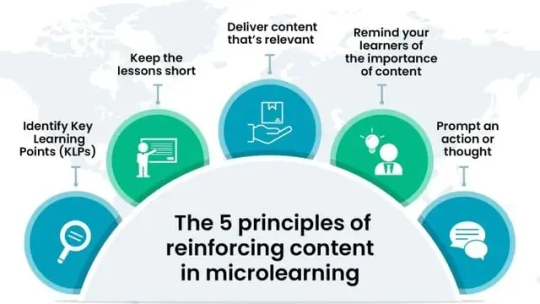
It started with a tweet.
One customer. One post. One viral complaint about unethical treatment by a frontline employee.
Within hours, the brand was trending—for all the wrong reasons.
In just 48 hours, that one incident spiraled into a full-blown PR crisis, prompting investigations, employee suspensions, and customer boycotts. The company’s stock dropped 12%, partnerships were put on hold, and loyal fans began questioning what they once believed in.
So, what went wrong?
The company had policies. The company had handbooks. But what it lacked was a culture of compliance—and a workforce trained to live its values, not just recite them.
This story isn’t fictional. It’s a real representation of what happens when companies treat compliance as paperwork instead of people work.
The turning point? Investing in modern, effective compliance training that reshaped not only the workforce—but the brand’s reputation.
Let’s explore how compliance training, when done right, becomes one of the most powerful tools for brand protection and trust building—and how platforms like MaxLearn are leading this transformation.
The Silent Threat: Compliance Gaps in Action
Many organizations operate under the illusion that having policies is enough. But the reality is, compliance failures usually stem from human misunderstanding or neglect—not from the absence of rules.
When employees:
Aren’t trained to handle sensitive situations
Don’t understand the ethical expectations tied to their role
Can’t identify red flags or escalation protocols
Aren’t aware of legal consequences
…mistakes happen. And today, even small mistakes are magnified online, shared widely, and tied directly to brand reputation.
The bottom line? Every employee represents your brand. If they act unethically—even unintentionally—it becomes a reflection of your company’s values.
Compliance Training: A Reputation Lifeline
In the aftermath of the incident, the brand from our story partnered with a learning platform to rebuild trust from the inside out. That platform? MaxLearn.
Why? Because MaxLearn offered more than boring e-learning modules. It delivered a compliance training ecosystem designed to change behavior, build awareness, and prevent future crises.
Let’s break down how it worked—and how any business can replicate that success.
How MaxLearn Transformed Training into Brand Protection
1. Microlearning That Stuck
Instead of dumping hours of content in one go, MaxLearn delivered short, focused modules that employees could consume daily. This spaced learning model helped reinforce key policies over time, increasing retention and relevance.
2. Real-World Scenarios
Training included case studies and simulations based on actual events. Employees learned not just what the rules were—but how to act when facing pressure, ethical dilemmas, or customer complaints.
3. Personalized Learning Paths
Customer service staff learned about conflict resolution and discrimination laws. Procurement teams dove into anti-corruption modules. Executives explored governance, accountability, and whistleblower policies.
4. Gamified Progress
To keep learners engaged, MaxLearn incorporated badges, challenges, and performance scores—turning learning into a proactive, rewarding experience.
5. Data-Driven Feedback
Leaders received dashboards showing knowledge gaps, participation rates, and compliance hotspots—allowing them to intervene early and make smarter decisions.
Rebuilding the Brand, One Employee at a Time
In just six months:
✅ Complaint volume dropped by 40% ✅ Internal reports of misconduct increased (a good sign—it meant employees were aware and empowered) ✅ Public sentiment improved as the company openly communicated its commitment to ethical behavior and employee development ✅ Partner confidence was restored, and stock value recovered
More importantly, employees started living the brand values, not just reading them.
Why This Matters for Every Business
Your reputation isn’t just built on your advertising or your product. It’s built on how your people behave—in customer service, in hiring, in data handling, in decision-making.
And the only way to shape behavior is through continuous, thoughtful, and human-centered compliance training.
Whether you’re a startup or a global giant, the risks are the same:
Legal fines
Social backlash
Investor skepticism
Employee disengagement
Customer churn
What separates resilient brands from the rest is how they prepare.
The Compliance Culture Shift
The most successful organizations are flipping the narrative. They don’t ask, “How do we avoid penalties?” They ask, “How do we build trust through our actions?”
This means:
🔁 Moving from one-time training to ongoing learning 🧠 Teaching ethical thinking, not just rule-following 💬 Encouraging open conversations about risk and responsibility 🎯 Aligning training with the brand mission, not just legal checklists
When employees see compliance as a shared responsibility and not a legal burden, they act accordingly. That’s when real change begins.
Making the Business Case to Leadership
Still not sure if investing in compliance training is worth it? Consider this:
Reputation accounts for over 60% of a company’s market value (according to research from Reputation Institute)
Employees trained on ethics are 50% less likely to engage in risky behavior
Companies with strong compliance programs face fewer lawsuits, lower fines, and greater investor trust
In short, compliance training isn’t a cost center—it’s a value driver.
And in a world where brand trust is make-or-break, it’s one of the smartest investments a business can make.
Final Takeaway: Training Builds Trust. Trust Builds Brands.
Your brand is built one interaction at a time—by real people making real decisions. And while marketing may introduce your values to the world, training is what ensures they’re lived every day.
The brand in our story survived not because of a great apology—but because they chose to turn a crisis into an opportunity for internal change.
With platforms like MaxLearn, companies of all sizes now have access to modern, adaptive training that does more than tick boxes—it builds culture, reinforces trust, and protects reputations.
#compliance training#compliance training online#compliance training for employees#compliance courses#hr compliance training#corporate compliance training#compliance officer training#hr compliance courses#environmental compliance training#staff compliance training#safety and compliance training#safety compliance training#annual compliance training#ethics and compliance training#training for compliance#regulatory and compliance training#compliance safety training#yearly compliance training#Compliance Microlearning#microlearning compliance training#corporate compliance microlearning#compliance microlearning solution#micro-learning platform for frontline employees#microlearning tool for frontline staff#microlearning platform#LmsTraining#training individual#on a job training#compliance and training#corporate compliance microlearning solution
0 notes
Text
How I Learned to Protect My Crypto from Rug Pulls—And Why STON.fi is My Safe Haven

The first time I witnessed a rug pull, it wasn’t just a headline or a distant story—it was real. A friend, eager to capitalize on the latest DeFi farming opportunity, went all in on a promising new project. The marketing was sleek, the community was buzzing, and the returns? Insanely high. It felt like the perfect play.
Then, in an instant, everything disappeared. The website? Gone. The Telegram group? Deleted. The developers? Nowhere to be found. His funds? Completely drained.
It was a painful lesson. And it made me realize that in the wild west of crypto, if you don’t know how to protect yourself, you will get burned.
Understanding Rug Pulls: The Trap That Catches Many
A rug pull is one of the most common scams in crypto. It happens when the creators of a token or DeFi platform lure investors in, pump up the price or liquidity, and then suddenly drain the funds, leaving traders with worthless tokens.
Rug pulls take different forms, but they usually follow the same playbook:
1. The Hype Phase – A new project appears with a slick website, aggressive marketing, and a growing community. Promises of high returns lure investors in.
2. The Price Surge – As more people invest, the token price soars. Developers encourage holders to "HODL" while adding liquidity to boost confidence.
3. The Exit – Once enough money is locked into the liquidity pool, the developers withdraw everything, making the token worthless.
For the unprepared, it's devastating. But it’s not unavoidable.
How to Spot and Avoid Rug Pulls
After seeing too many people lose money, I made it a rule to vet every project I invest in. Here’s what I look for:
1. Liquidity Locking
If the liquidity isn't locked, that’s a massive red flag. Reputable projects lock liquidity for a certain period to prevent sudden withdrawals. If there’s no liquidity lock—or it’s only locked for a few days—run.
2. Token Distribution
If a few wallets hold most of the supply, you’re at risk. Developers can dump their tokens at any time, crashing the price. Always check the tokenomics and distribution before investing.
3. Smart Contract Audits
A serious project will have an audit from a reputable firm like CertiK, PeckShield, or Hacken. But don’t just take their word for it—read the audit reports. Some scams still get audits, but the reports often highlight vulnerabilities.
4. Real Utility Over Hype
If the only selling point of a project is "high APY" or "fast gains," it's a trap. A solid project has a real product, a clear use case, and long-term sustainability.
5. Community and Transparency
Do the developers interact with their community? Do they hold AMAs? If everything feels anonymous and controlled, it's another sign of trouble.
Why I Trust STON.fi in a Market Full of Risks
After seeing countless scams, I needed a platform that actually valued security, transparency, and real utility. That’s how I found STON.fi, a decentralized exchange built on The Open Network (TON) blockchain.
Here’s why STON.fi stands out in an industry full of risks:
1. Liquidity Security
STON.fi ensures that liquidity is safe by using immutable smart contracts and TON’s robust blockchain architecture. This means that no one— not even the developers—can suddenly drain liquidity.
2. No Middlemen, No Fake Promises
Unlike centralized exchanges or shady DeFi projects, STON.fi operates with pure decentralization. Trades are executed peer-to-peer, eliminating the risk of insider manipulation.
3. Smart Contract Transparency
STON.fi’s smart contracts are fully open-source and audited, ensuring users can verify the security and legitimacy of the platform.
4. Sustainable Growth, Not Ponzi Models
Many platforms lure users in with unrealistic APYs—but those numbers are often unsustainable. STON.fi focuses on real DeFi mechanics, allowing traders to earn yield through actual market activity, not artificial inflation.
5. Designed for Traders, Built for Safety
With features like:
Fair pool mechanics that prevent price manipulation
Real-time analytics to track token liquidity and volume
Efficient routing for the best swap rates
STON.fi gives traders an environment where they can invest confidently without worrying about the next rug pull.
Final Thoughts
Crypto is full of opportunities, but it’s also full of traps. If you're not careful, you’ll fall into one. I learned my lesson the hard way, but platforms like STON.fi have shown me that DeFi can be safe when built with the right principles.
The next time you’re about to ape into a new project, ask yourself: Is this secure, or am I just following hype? Because in crypto, the difference between wealth and ruin is often just one decision away.
0 notes
Text
Crypto Weekly: LIBRA’s Downfall, FTX’s Big Payoff, YZY Token’s Rise and Hamster Kombat’s Return
Key Points
The top crypto news this week includes the launch of the LIBRA meme coin, a $1.2 billion payout from FTX to creditors, and the debut of Hamster Kombat Season 2.
Bitcoin’s price approached $100,000, reaching a market capitalization of approximately $3.3 trillion. Bitwise Asset Management became the first Bitcoin ETF provider in the US to reveal its on-chain wallet address.
This week in the crypto world, the launch of the LIBRA meme coin, Bernstein’s analysis of potential US Bitcoin reserve plans, and a $1.2 billion payout from FTX to creditors were the highlights. In addition, the second season of Hamster Kombat made its debut, among other news.
On February 21, the price of Bitcoin neared $100,000, achieving a market capitalization of approximately $3.3 trillion at the time.
Bitwise Reveals On-Chain Wallet Address
Bitwise Asset Management became the first Bitcoin ETF provider in the US to disclose the on-chain address of its spot Bitcoin ETF (BITB) holdings, a significant step towards enhancing transparency.
This move has sparked discussions about transparency among core Bitcoin ETF issuers. Now, investors can verify the asset manager’s Bitcoin holdings directly on the blockchain, ensuring that the assets are securely locked in.
Bitwise’s co-founder and CEO, Hunter Horsley, emphasized this move as a step towards greater transparency, stating that Bitwise is now the only US ETP issuer to openly share its wallet addresses.
Bernstein on US Bitcoin Reserve Plans
Bernstein analysts released a report on a national Bitcoin reserve, noting that establishing such a reserve would not be straightforward. A significant question was raised regarding which US government agency would be responsible for purchasing and managing the Bitcoin treasury.
The analysts suggested that either the Federal Reserve or the US Treasury could take on this role. They also highlighted the challenges the US would face in funding the purchase of Bitcoin. One potential solution could be for the Federal Reserve to issue debt or sell some US gold reserves.
According to the Bernstein analysts, this strategy would enable the US to raise the necessary funds to purchase Bitcoin. They also noted that the US government has confiscated approximately $20 billion worth of Bitcoin from criminal investigations.
The launch of the LIBRA meme coin resulted in a significant market pump and dump, leaving 86% of traders with losses. The LIBRA meme coin pump and dump led to a total loss of $251 million. However, winning trades managed to accumulate a total of $180 million in profits.
The Bitcoin mining hashrate is slowing down after months of rapid growth. Despite the slowdown, Bitcoin mining remains a billion-dollar industry, bringing in $1.4 billion in revenue last month.
On February 18, the Bahamian branch of FTX began reimbursing smaller creditors, marking the first step in a distribution process aimed at restoring confidence in the crypto ecosystem.
As Bitcoin prepares for the exciting phase of the 2025 bull rally, Strategy (formerly known as MicroStrategy) has announced key details of how it plans to purchase the ongoing dip.
Telegram game Hamster Kombat is back with the debut of its Season 2, offering a new gameplay experience. Players can now build developer teams to create games and boost their earnings.
Kanye West, now known as Ye, is launching YZY, a cryptocurrency designed to power his business empire and bypass traditional platforms such as Shopify.
0 notes